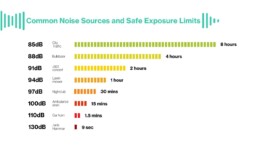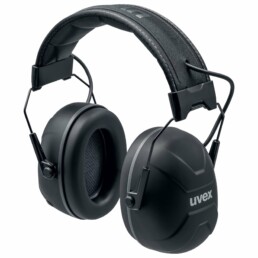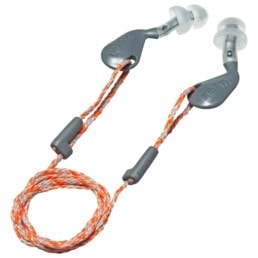Excessive noise at work is not just a nuisance; it poses a serious threat to the hearing health of employees, potentially leading to temporary or permanent hearing loss. This is referred as Noise Induced Hearing Loss (NIHL). Permanent Noise Induced Hearing Loss is irreversible damage, making it imperative for employers to prioritise effective noise control measures. Equipping workers with the appropriate hearing protection not only protect their auditory health but also contribute to maintaining productivity and minimising disruption to their workflow.
When is hearing protection required?
If you are in a noisy environment without wearing any hearing protection and you must raise your voice to communicate with someone next to you, it is a good indication that a form of hearing protection is required. In addition to this, even if the measured 8-hour equivalent noise exposure of 85dB (LAeq, 8h) is not exceeded but you have impulse noise events present in your surrounding that are above 85dB or cause disruption to your concentration, the use of an appropriate hearing protection is recommended – even if it is only for the duration of the impulse noise event. Impulse noises can distract workers and in sufficient amounts, can affect their productivity.
LAeq, 8h – the 8-hour Equivalent Continuous A-Weighted Sound Pressure (Noise) Level
The 8-hour equivalent continuous A-weighted sound pressure level is calculated by using the following equation. It adds all the noise events experienced during a shift and then adjusts it to an equivalent 8-hour period:

Where ti is the duration of each noise in hours and SPL (Sound Pressure Level) is its magnitude in decibels (dB).
Using the same relationship, you can also calculate the maximum time a worker can be exposed to a particular noise event (sound pressure level measured in dB) before the daily limit of LAeq, 8h of 85 dB is exceeded. An impact wrench, as an example, which is emitting a sound pressure level of 120dB as measured at the worker’s ear-level for a period of 15 minutes would result in a weighted time average of 104.95dB.
Using the same relationship, you can also calculate the maximum time a worker can be exposed to a particular noise event (sound pressure level measured in dB) before the daily limit of 85dB is exceeded.
For example, a worker can be exposed to a noise event at 100dB for a maximum of 15 minutes before they exceed their daily legislative noise limit. as per the WHS Regulations. Likewise, a worker can only be exposed to a noise event at 110dB for a maximum of 1.5 minutes before their daily legislative noise limit is exceeded. As can be seen, exceeding the permitted legislative daily noise limit can be done quickly and easily without any realisation from the worker, thereby putting their workplace at risk of non-compliance and the worker at a significantly higher risk of sustaining permanent hearing loss.
Examples of noise events along with their maximum duration of exposure before the daily noise limit is exceeded can be seen below.

As can be seen, exposing unprotected ears to high noise levels for even a brief period can make a worker exceed their daily noise limit very quickly.
uvex xact-fit and uvex xact-fit reusable Earplugs
The uvex xact-fit is a corded disposable earplug with replaceable pods and reusable ergonomically shaped insertion pins. It has a SLC80 of 22dB (the level of noise reduction a hearing protector is expected to provide, as measured in a laboratory setting according to AS/NZS 1270) and are classed as Class 4 hearing protectors. The replacement pods offer a hygienic solution while the reusable insertion pins simplify earplug insertion. An adjustable cord has been incorporated for maximum worker comfort.
The uvex xact-fit reusable earplugs have a SLC80 of 19dB (Class 3) and come in two sizes to suit small and medium sized ear canals. Like the uvex xact-fit, the uvex xact-fit reusable have oval-shaped earplugs with ergonomically shaped stems that facilitate effortless and comfortable insertion and removal in the ear canal. Suitable for multiple uses, only soap and water is needed for regular cleaning.
Since the uvex xact-fit range of earplugs do not need to be rolled up for insertion into the ear canal, they can be inserted and taken out even while wearing gloves with little effort and disruption to a worker’s workflow. Workers can wear the uvex xact-fit range of earplugs during impulse noise events and take them out when hearing protection is no longer required with ease.
uvex aXess one Earmuffs
For noisy work environments where communication is also important, the uvex aXess one earmuffs with the adjustable Real Active Listening (RAL) feature and Bluetooth connectivity to up to two devices is an ideal solution. The RAL feature listens and allows surrounding sounds to be transmitted through the integrated speakers of the uvex aXess one at a comfortable and safe level.
The wearer can increase or decrease the RAL volume according to the level of external sounds they want to hear. This allows the wearer to be continuously protected from noise while maintaining situational awareness, thereby decreasing their risk of accidents and injuries.

If you need assistance in choosing the right hearing protection for your workers contact uvex safety Australia.
